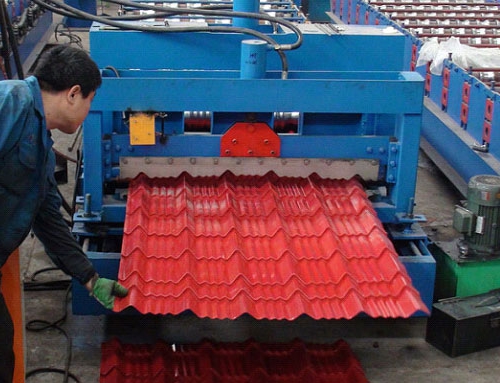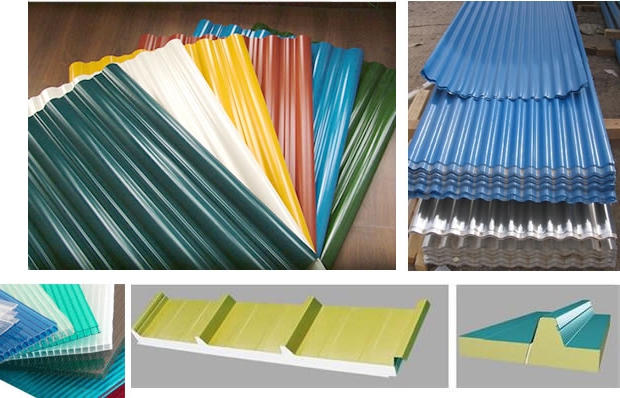
Metal - a roofing material made on a metal basis. A protective and decorative polymer coating is applied on top of it. In general, the metal tile is a large sheet with a pattern that imitates an evenly laid tile.
The use of such a roofing material makes it possible to save on labor costs, because sheets of large size are laid much faster and easier than small individual elements. In addition, the metal tile is of high quality, because when it is laid, fewer joints are obtained, and relatively light weight, for example, clay tiles weigh six times more.
Characteristics of the roofing material
A business plan for the production of metal should be drawn up after you decide which direction to choose. There are two options - to directly produce the material or to pack it (or to do both). Sheets are made of aluminum or galvanized steel. The choice of these metals is due to their resistance to atmospheric precipitation.
To give the coating an external appeal and even greater strength, several layers of colored plastic with a thickness of 27-50 microns are applied to the sheet on both sides. The length of the sheets, depending on the needs of customers, ranges from forty centimeters to eight meters. Width - about a meter, thickness - half a meter. The service life of the material is up to fifty years.
Stacking
Briefly talk about how the process of laying metal tiles occurs. First, individual sheets are mounted on a waterproofing coating. Then they are fixed to the crate with the help of special self-tapping screws that are resistant to corrosion. In the coating itself, pre-drilling is not required. Sheets overlap. In addition, you can mount them on top of the old wood roof.

Types of metal
Manufacturers distinguish three main classes of material, the difference of which is the thickness of the metal. As a result, the sheet may have a thickness of 0.37-0.75 mm. Many European companies, for example, Swedish, use thin metal (up to 0.4 millimeters). Such sheets weigh less, but they are quite difficult to mount, so most Russian manufacturers use thicker material.
However, there are nuances here. For example, steel with a thickness of more than 0.55 millimeters is difficult to mold, a specialized processing line will be required to work with such metal. For the production of metal, it is best to use sheets with a thickness of 0.5 mm.
They have the necessary margin of safety, are easily molded and fit well together. When choosing raw materials (metal), preference should be given to domestic manufacturers, rather than Chinese: their material cost is higher, but the quality is much better.
Technology for the production of metal
The process consists of several stages. First, a sheet of metal roll is mounted on an unwinder. Then the sheet (already expanded) is fed to a rolling machine for the production of metal, where it is subjected to longitudinal rolling and transverse stamping.
Then, galvanize the metal on both sides, so that the surface becomes resistant to corrosion.After this, passivation of the sheet is carried out to protect the metal from oxidation and ensure adhesion (good adhesion of the substrate to the ground). Next, the passivated surface is primed.

Polymer coating
The next step is the application of the polymer layer. It has a thickness of only 35 microns, but despite this it is quite resistant to temperature extremes and the influence of ultraviolet radiation, therefore it is able to last a long time. Also, the coating has fire resistance.
The polymer composition, as a rule, is applied only to the upper side of the sheet, while the lower one is covered with a colorless protective layer. Various materials can be used as coatings, for example, pural, polyester, plastisol. The advantage of polyester is its cheapness, while it has good resistance to wear and temperature changes, is not damaged during molding.
Applied in a layer of 25 microns. Pural allows you to give the surface a silky matte pleasant structure. Use a material with a thickness of 50 microns, if it is thicker, then the resistance to negative factors will increase, however, in this case there will be difficulties in molding.
Plastisol is applied in the thickest layer - 200 microns. This material has excellent resistance to temperature and mechanical influences and is presented in the widest range of colors, but it has a drawback - it quickly heats up and burns out under direct sunlight.

The final stages of the production process
After applying the polymer coating, the material is sent to the molding apparatus, where it takes on the desired form. Then follows the step of cutting into individual sheets of the desired size. After that, the controllers carry out product quality control, packaging and shipping to the warehouse.
So we briefly reviewed what constitutes the production of metal. The plant should be equipped with a forklift, which will prevent losses at the stage of packaging and moving sheets. The material is packed in pallets, in order to avoid deformation during transportation to the wooden pallet, the tiles are screwed with metal tapes.
To protect the surface from possible scratches and chips, soap solution is poured between the individual sheets. Some manufacturers lay each layer with plastic wrap. The sheets laid in pallets are closed from the sides with cardboard inserts, after which the package is wrapped in dense polyethylene.

Equipment for the production of metal
The production line contains a roll forming machine. This is perhaps the main unit, because it is thanks to it that the sheet acquires a characteristic texture. In general, how many types of roofing material you can make will depend on the equipment of the line. In the business plan for the production of metal, include the calculation of equipment costs.
The minimum cost of the line starts from three million rubles. Please note that in addition you need to purchase a forklift, work tools, a crane-beam. Equipment for the production of metal tiles is about twenty meters long, about three meters wide, and two meters high. Therefore, to place the line requires an area of not less than one hundred square meters.
Business features
The activity we are considering is quite promising and profitable, but it requires a relatively large starting capital. A business plan for the production of metal tiles must be prepared carefully and thoughtfully, taking into account all costs.
These are costs for equipment, its delivery, installation, commissioning (at least 4.5-5 million rubles), for the purchase of raw materials (at least 1 million for the first batch), payment of rental space, wages to employees, and so on. It should be noted that there is serious competition in this market segment.Therefore, the business plan for the production of metal should also contain a calculation of the costs of the advertising campaign. Good luck!
